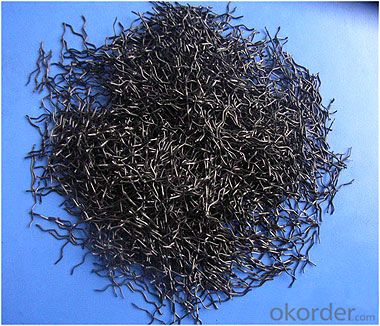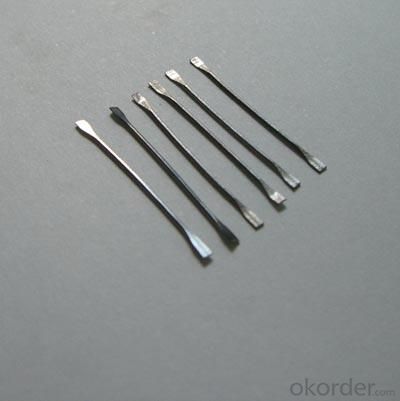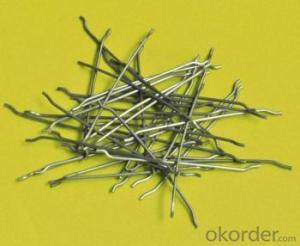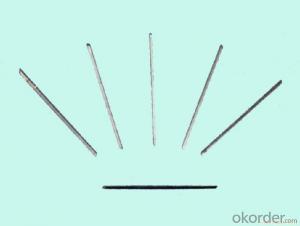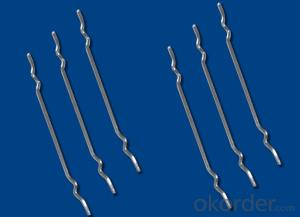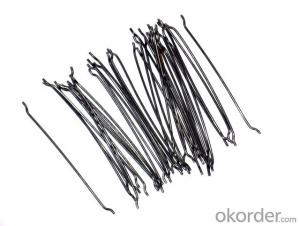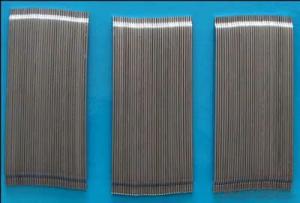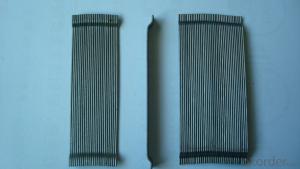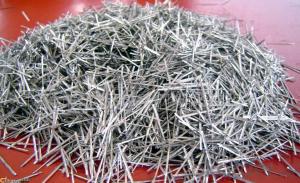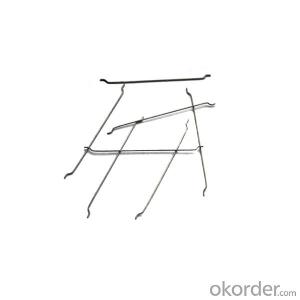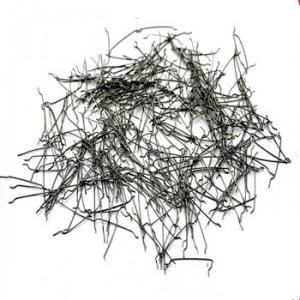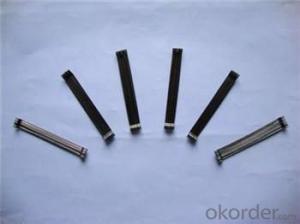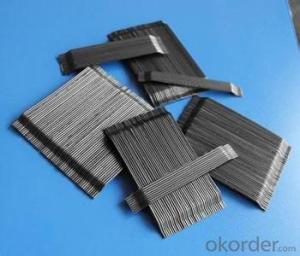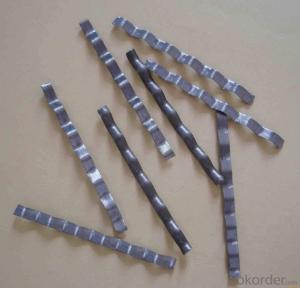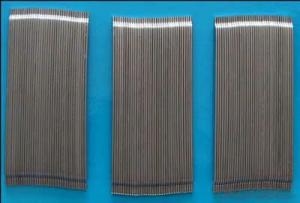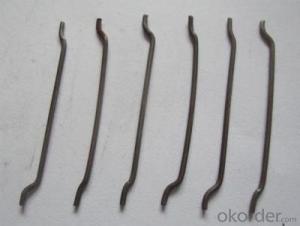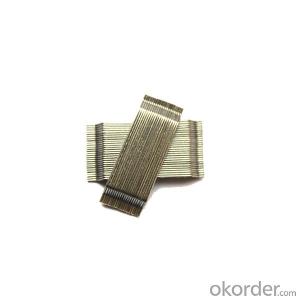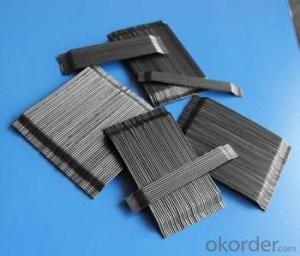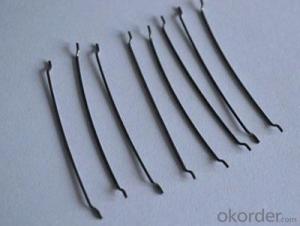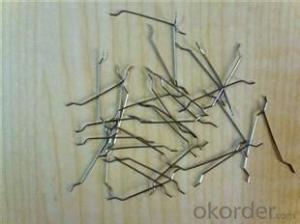Melt Extract Stainless Steel Fiber - High Tensile Strength for Concrete
- Loading Port:
- Tianjin
- Payment Terms:
- TT OR LC
- Min Order Qty:
- 1000 kg
- Supply Capability:
- 30000 kg/month
OKorder Service Pledge
OKorder Financial Service
You Might Also Like
Quick Details
Place of Origin: Jiangsu, China (Mainland)
Model Number: HT-MC
Material: Color Steel
certificated: ISO 9001
The Products
The milled steel fiber is made of high-strength steel wire through milling process, which makes the wire into wave shape to increase the touching area with concrete. By tightly binding with the mortar, the steel fiber can greatly enhance the performance of steel-fiber reinforced concrete, with strong cracking and shearing resistance, and tensile strength.
Specifications
1.material: steel plate
2.shape: waved
3.thickness: 0.5-13mm
4.length:35-5mm
5.tensile strength: >800Mpa
Specification | Thickness (mm) | Width (mm) | Length (mm) | Length- diameter l/d | Tensile strength (MPa) | Bending property |
T×W×L | 0.5-1.3 | 2-4 | 35-50 | 70~38 | ≥600 | ≥3 |
Picture
Steel fiber
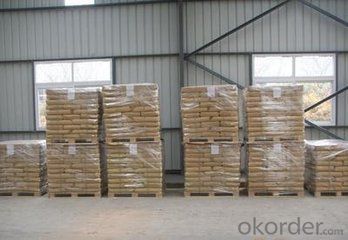
any type
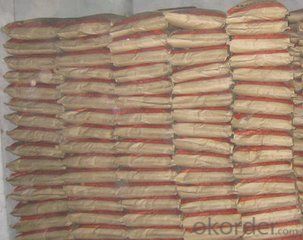
pp bag
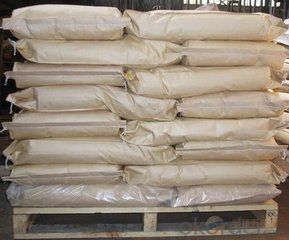
FAQ
See larger image
glued steel fibre in a row >1200Mpa
In using the steel fiber, proper mixing is one of the critical step, which will decide all physics and chemistry performance of the steel fiber reinforced concrete. Therefore, scientific mixing is needed to ensure the best performance of the steel fiber reinforced concrete, so that the index will reach and exceed the desired standard.
- Q: Are there any limitations or drawbacks of using melt extract stainless steel fiber?
- Using melt extract stainless steel fiber does have limitations and drawbacks. One limitation is the high cost associated with this type of fiber. Compared to other fibers, melt extract stainless steel fibers are expensive, making them less accessible for projects with budget constraints. Another drawback is the potential for corrosion. Although stainless steel fibers are generally resistant to corrosion, they are not completely immune. Depending on the environment and conditions they are exposed to, there is a possibility of corrosion occurring over time, compromising the fiber's durability and performance. Moreover, handling and installing melt extract stainless steel fibers can be challenging. They are typically stiff and difficult to bend, making it complex to incorporate them into certain applications or structures. This can lead to difficulties during installation and potentially impact the overall effectiveness of the fiber. Furthermore, the size and length of these fibers may also present limitations. They are usually available in shorter lengths compared to other fibers, restricting their use in applications that require longer fiber lengths. Lastly, the thermal conductivity of stainless steel fibers can be a drawback in certain situations. While their high thermal conductivity can be advantageous in some applications, it can also be a limitation. For projects where thermal insulation is a priority, the thermal conductivity of stainless steel fibers may not meet the desired requirements. In conclusion, while melt extract stainless steel fibers offer benefits such as high tensile strength and excellent resistance to high temperatures, it is important to consider their limitations and drawbacks before choosing them for a specific project or application.
- Q: How does melt extract stainless steel fiber improve the crack resistance of concrete?
- The crack resistance of concrete is enhanced by melt extract stainless steel fiber in several ways. To begin with, the inclusion of stainless steel fibers in the concrete mix helps to evenly distribute stresses throughout the entire structure. These fibers form a three-dimensional network within the concrete, reinforcing it and preventing cracks from spreading while also improving the efficiency of applied loads. Furthermore, the crack resistance of concrete is improved by the high tensile strength and ductility of stainless steel fibers. These fibers possess exceptional mechanical properties that enable them to absorb and dissipate energy when exposed to external forces or changes in temperature. Consequently, they provide greater resistance to cracking caused by shrinkage, temperature fluctuations, and external loads. Another important factor is the capability of stainless steel fibers to control crack width and limit its propagation. Acting as small bridges across cracks, these fibers reduce their width and prevent them from expanding further. This limitation of crack width ensures the integrity and longevity of the concrete structure. Additionally, stainless steel fibers enhance the flexural strength and toughness of concrete. This increased flexural performance enables the concrete to withstand higher bending stresses and deformations without cracking. Consequently, it enhances the overall crack resistance of the concrete, making it more resistant to initial and subsequent cracking under load. In summary, the addition of melt extract stainless steel fiber significantly improves the crack resistance of concrete by establishing a reinforcing network, absorbing energy, controlling crack width, and enhancing flexural strength and toughness. These combined effects result in a more durable and reliable concrete structure, with reduced cracking and increased resistance to various external factors.
- Q: Is melt extract stainless steel fiber compatible with all types of concrete curing methods?
- The compatibility of melt extract stainless steel fiber with various concrete curing methods is not universal. While these fibers can enhance the mechanical properties of concrete, their effectiveness may vary based on the specific curing method employed. If high-temperature curing methods, such as steam curing or autoclaving, are used, the mechanical properties of melt extract stainless steel fibers may be compromised due to the excessive heat. Consequently, the overall performance of the concrete may deteriorate. Conversely, when traditional curing methods like air curing or water curing are utilized, melt extract stainless steel fibers can be compatible and offer valuable reinforcement to the concrete. These fibers can augment the concrete's tensile strength, resistance to cracks, and durability, resulting in improved performance and longevity. To ensure successful integration of melt extract stainless steel fibers in concrete applications, it is crucial to carefully consider the specific curing method and its impact on these fibers. Seeking advice from experts and conducting thorough testing can help determine the compatibility and effectiveness of these fibers across different curing methods.
- Q: Can melt extract stainless steel fiber be used in tunnel construction?
- Melt extract stainless steel fiber is indeed applicable to tunnel construction. Renowned for their exceptional tensile strength, resistance to corrosion, and long-lasting nature, stainless steel fibers are perfectly suited for endeavors that demand structural integrity, like tunnel construction. These fibers have the ability to enhance the mechanical attributes of concrete, thereby bolstering its ability to withstand cracking, thermal expansion, and shrinkage. Moreover, they can serve as reinforcement within tunnel linings, thereby reducing the necessity for conventional reinforcement techniques like rebar. This leads to considerable cost savings and quicker completion times. All in all, melt extract stainless steel fiber is a trustworthy and efficient option when it comes to tunnel construction projects.
- Q: How does the addition of melt extract stainless steel fiber affect the creep behavior of concrete?
- The addition of melt extract stainless steel fiber positively affects the creep behavior of concrete. Creep is the time-dependent deformation of concrete under a constant load, and it is a significant concern in structural applications as it can lead to long-term deformation and structural failure. When melt extract stainless steel fibers are incorporated into the concrete mix, they enhance the overall mechanical properties of the material. The fibers act as reinforcement, providing additional tensile strength and improving the concrete's resistance to cracking and deformation. The steel fibers also contribute to reducing the overall creep of concrete. They act as internal support, resisting the movement and redistribution of stresses within the concrete matrix. This reinforcement effect helps to distribute the applied load more evenly and reduces the potential for long-term deformation. Furthermore, melt extract stainless steel fibers improve the durability of concrete by increasing its resistance to environmental factors such as shrinkage, thermal cycling, and aggressive chemicals. This enhanced durability contributes to the long-term stability and performance of concrete structures. In summary, the addition of melt extract stainless steel fibers to concrete improves its creep behavior by enhancing its mechanical properties and reducing the potential for long-term deformation. This reinforcement effect leads to increased structural integrity and durability, making it an effective solution for applications where creep resistance is a concern.
- Q: What is the lifespan of melt extract stainless steel fiber in concrete?
- The durability and lifespan of melt extract stainless steel fiber in concrete can vary due to several factors, including fiber quality, application, and environmental conditions. Generally, melt extract stainless steel fibers are known for their long lifespan and resistance to corrosion. Under normal concrete conditions, the lifespan of melt extract stainless steel fiber can range from 20 to 50 years. This is possible because stainless steel has high tensile strength and corrosion resistance, enabling it to withstand harsh concrete conditions such as moisture, chemicals, and temperature changes. However, it's important to consider that the lifespan can be influenced by factors like fiber quality, concrete mix design, and the maintenance of the concrete structure. Proper installation, curing methods, regular maintenance, and inspections can significantly prolong the lifespan of stainless steel fiber in concrete. Additionally, the specific application of the concrete, such as heavy traffic areas or exposure to extreme weather conditions, can impact the lifespan of the stainless steel fiber. In such cases, applying surface coatings or sealants may be necessary to further protect the stainless steel fiber and enhance its longevity. Overall, melt extract stainless steel fiber is a reliable and durable reinforcement material for concrete structures. With proper care and maintenance, it can provide a lifespan of 20 to 50 years or even longer.
- Q: How does melt extract stainless steel fiber improve the resistance to corrosion in concrete?
- The resistance to corrosion in concrete is enhanced by melt extract stainless steel fiber through various mechanisms. Firstly, the stainless steel fibers function as a physical barrier, preventing the penetration of harmful substances such as chlorides and sulfates into the concrete and reaching the reinforcing steel. This barrier effect reduces the exposure of the steel to corrosive agents, minimizing the risk of corrosion. Secondly, stainless steel possesses inherent corrosion resistance due to its high chromium content. This alloying element creates a passive oxide layer on the steel's surface, which acts as a protective barrier against corrosion. When stainless steel fibers are added to concrete, this passive oxide layer helps shield the embedded steel from corrosive attacks, improving the overall durability and lifespan of the concrete structure. Moreover, incorporating melt extract stainless steel fibers enhances the mechanical properties of concrete, making it more resistant to cracking and shrinkage. By reducing crack occurrence and minimizing concrete permeability, the ingress of corrosive agents is significantly decreased, thereby enhancing the concrete's corrosion resistance. Additionally, the high tensile strength and ductility of stainless steel fibers provide an extra layer of reinforcement within the concrete matrix. This reinforcement ensures a more even distribution of stress throughout the structure, preventing localized weak areas that could initiate corrosion. To summarize, melt extract stainless steel fiber improves the corrosion resistance in concrete by acting as a physical barrier, providing inherent corrosion resistance, enhancing concrete's mechanical properties, and offering additional reinforcement. These combined effects contribute to the long-term durability and corrosion resistance of concrete structures in various environments.
- Q: Can melt extract stainless steel fiber be used in asphalt or bitumen?
- Yes, melt extract stainless steel fiber can be used in asphalt or bitumen. The addition of stainless steel fibers enhances the mechanical properties of the asphalt mixture, improving its durability, crack resistance, and fatigue resistance. Moreover, stainless steel fibers can also help in reducing rutting and thermal cracking in asphalt pavements.
- Q: Can melt extract stainless steel fiber improve the resistance of concrete to sulfate attack?
- Yes, melt extract stainless steel fiber can improve the resistance of concrete to sulfate attack. Stainless steel fibers have high corrosion resistance and can enhance the durability and strength of concrete by reducing cracking and improving its resistance to chemical attacks such as sulfate attack.
- Q: Can melt extract stainless steel fiber be used in earthquake-resistant construction?
- Indeed, melt extract stainless steel fiber is applicable for earthquake-resistant construction. By infusing concrete with these fibers, it gains augmented strength and durability, effectively enhancing its resistance to cracking and structural impairment during seismic events. Acting as reinforcement, the fibers play a crucial role in distributing and dissipating the energy produced by seismic activity. Furthermore, the exceptional corrosion resistance of stainless steel fibers guarantees the longevity and efficiency of concrete structures in areas prone to earthquakes. Consequently, the integration of melt extract stainless steel fiber into construction materials can substantially heighten the earthquake resilience of buildings and infrastructure.
Send your message to us
Melt Extract Stainless Steel Fiber - High Tensile Strength for Concrete
- Loading Port:
- Tianjin
- Payment Terms:
- TT OR LC
- Min Order Qty:
- 1000 kg
- Supply Capability:
- 30000 kg/month
OKorder Service Pledge
OKorder Financial Service
Similar products
Hot products
Hot Searches
Related keywords



